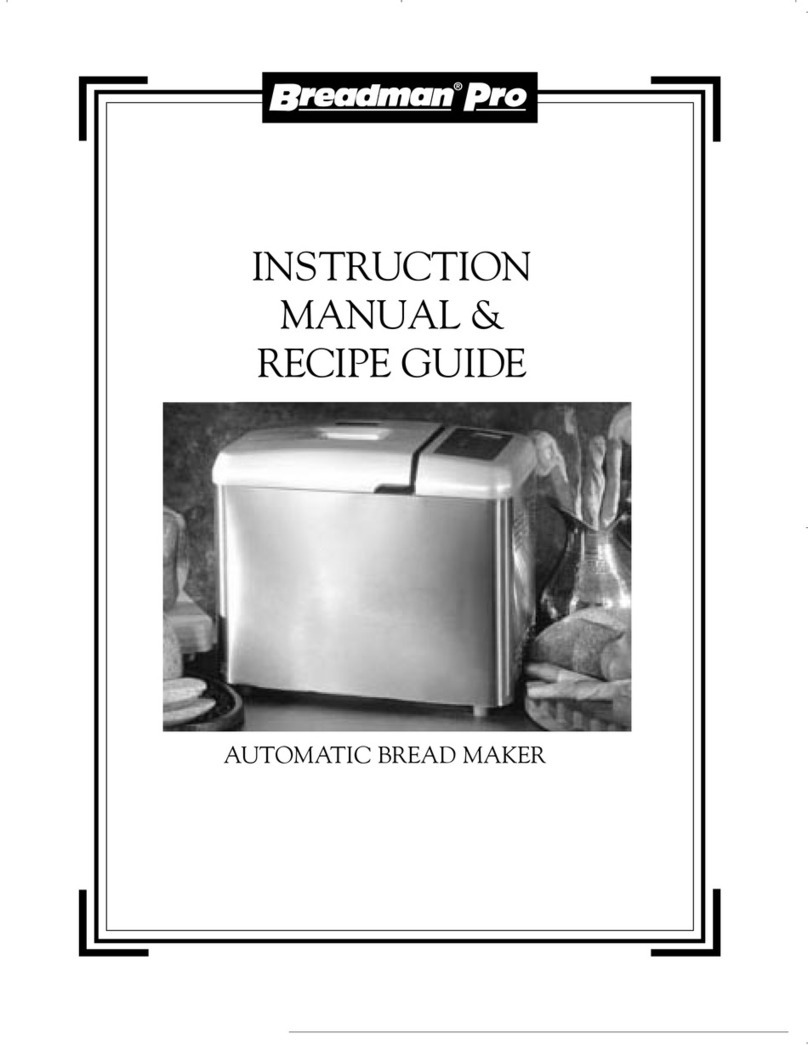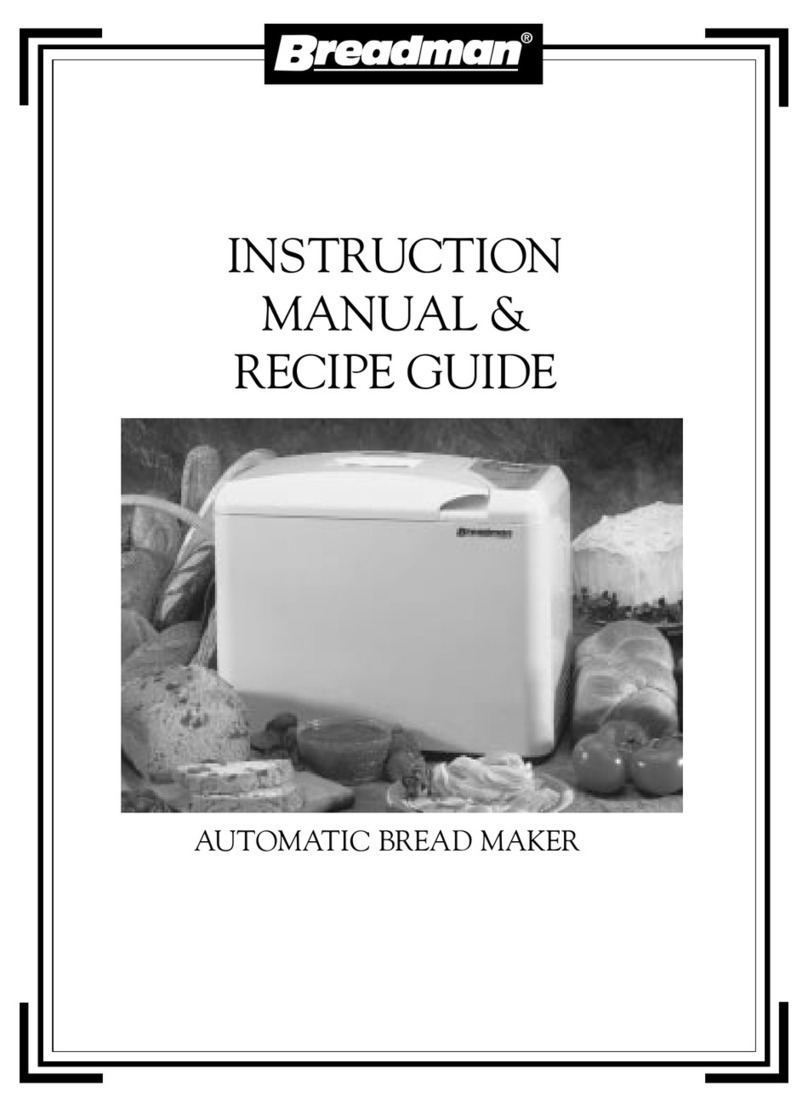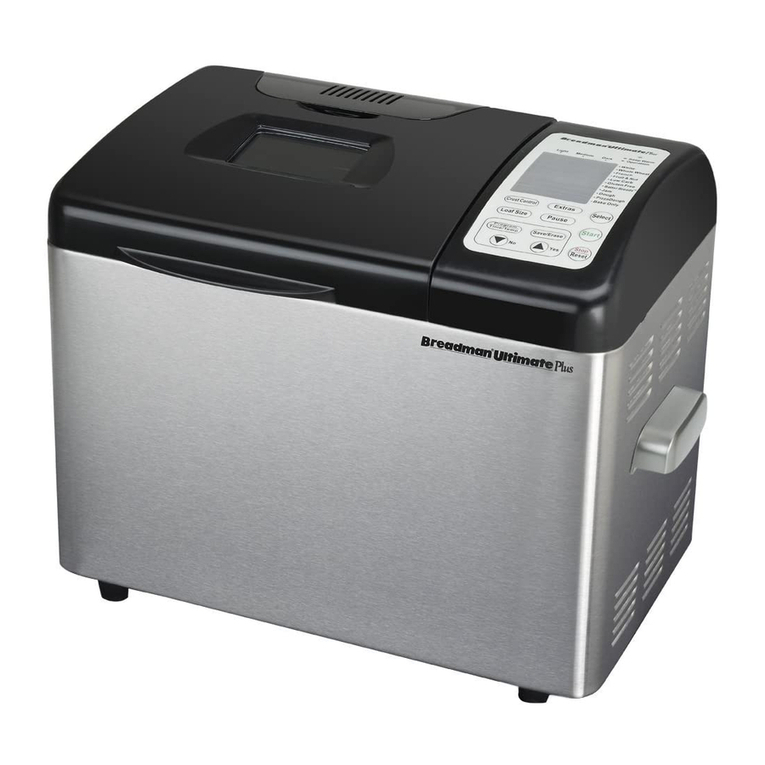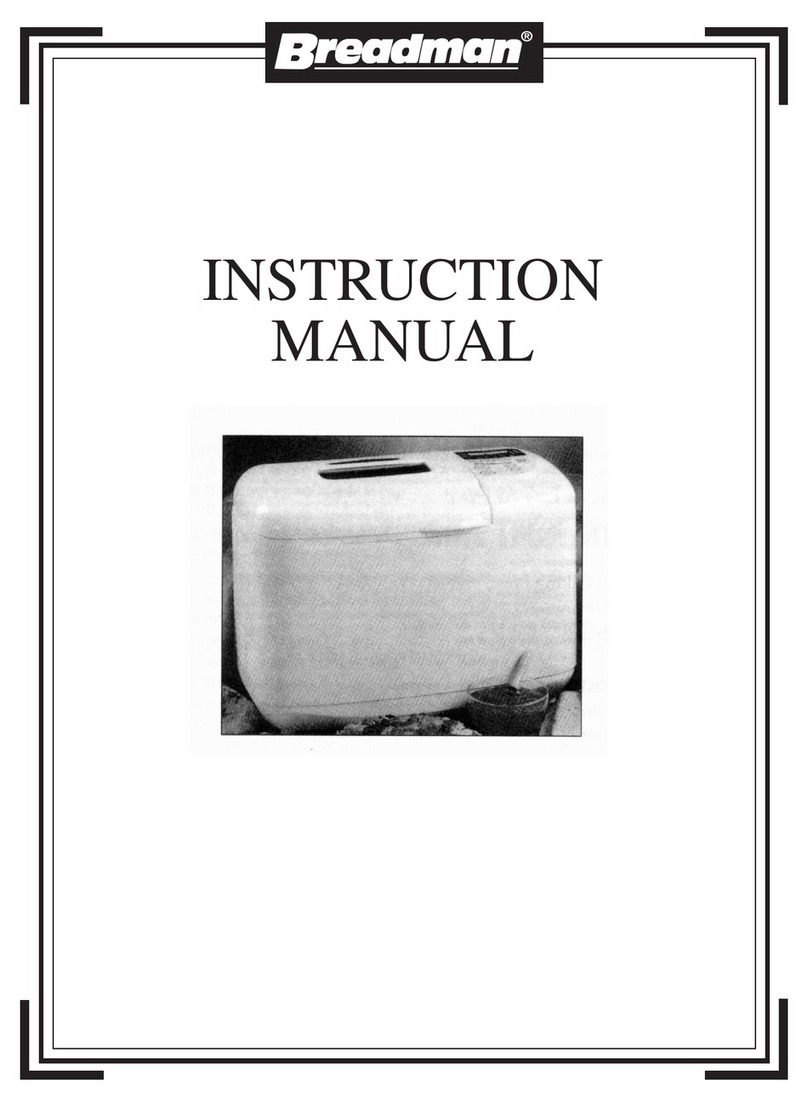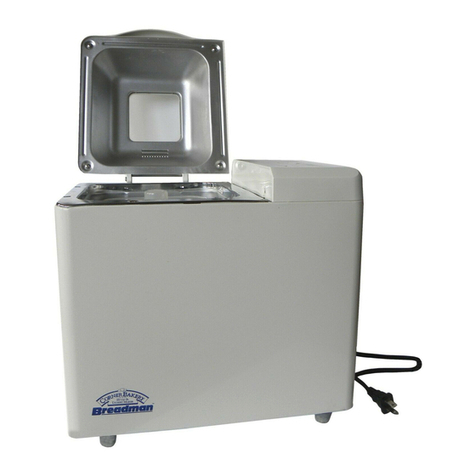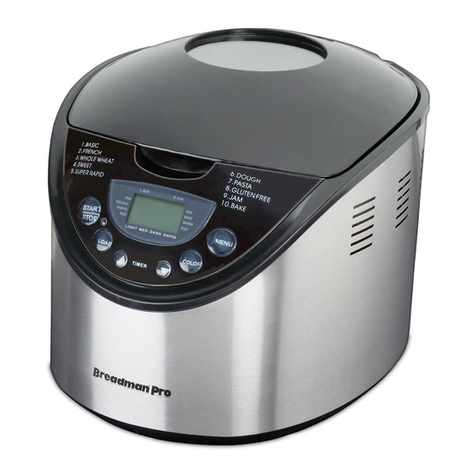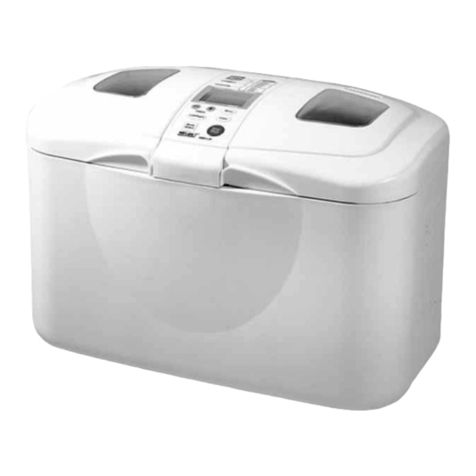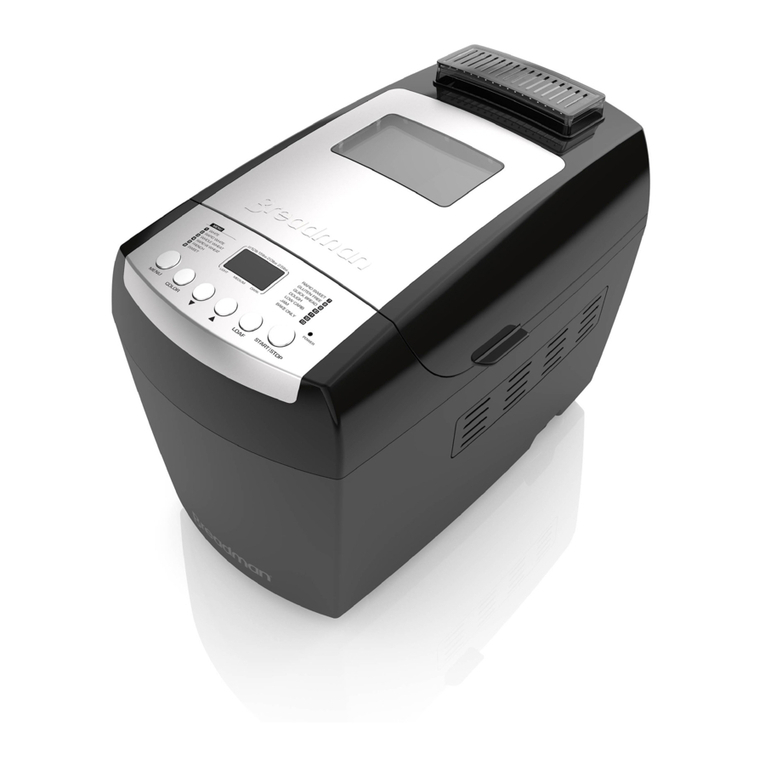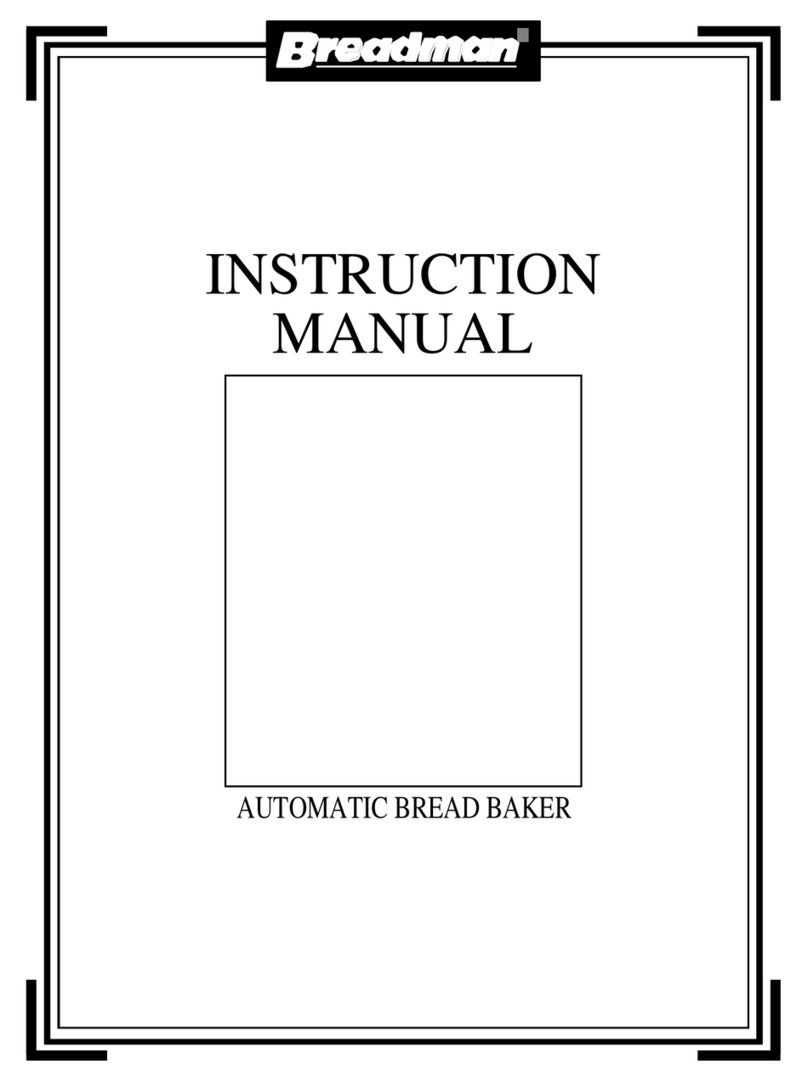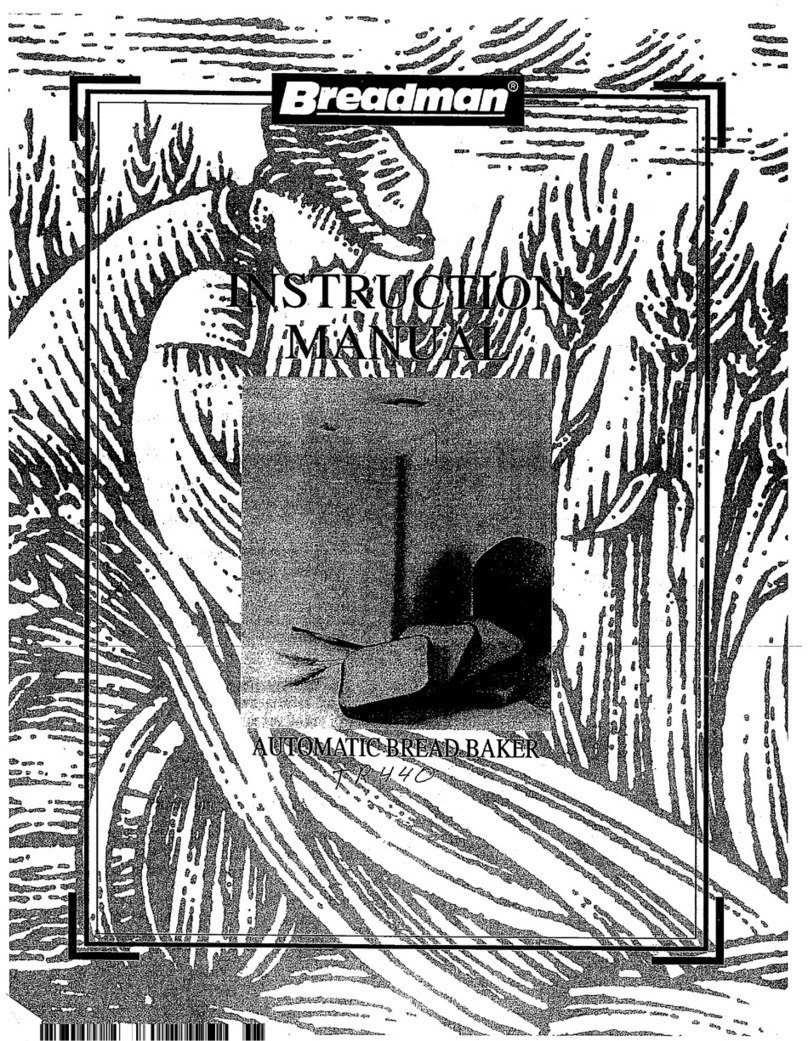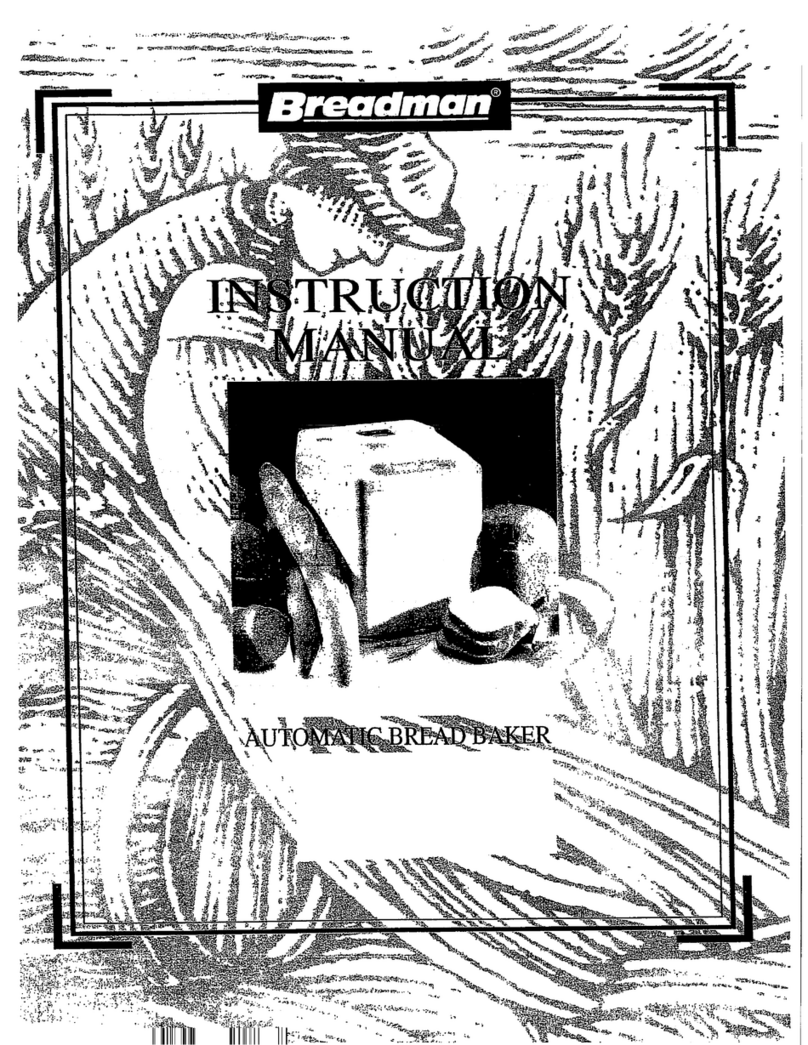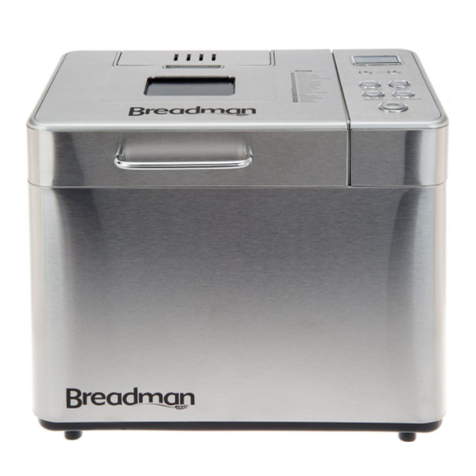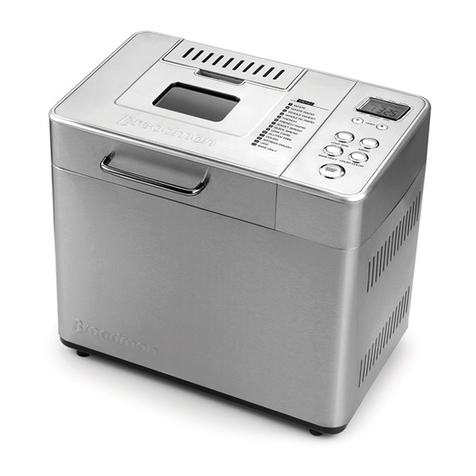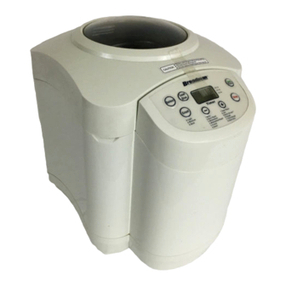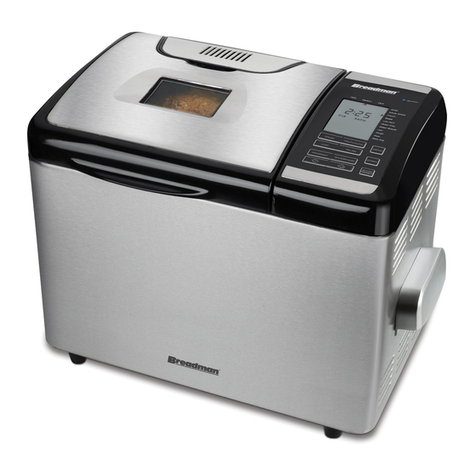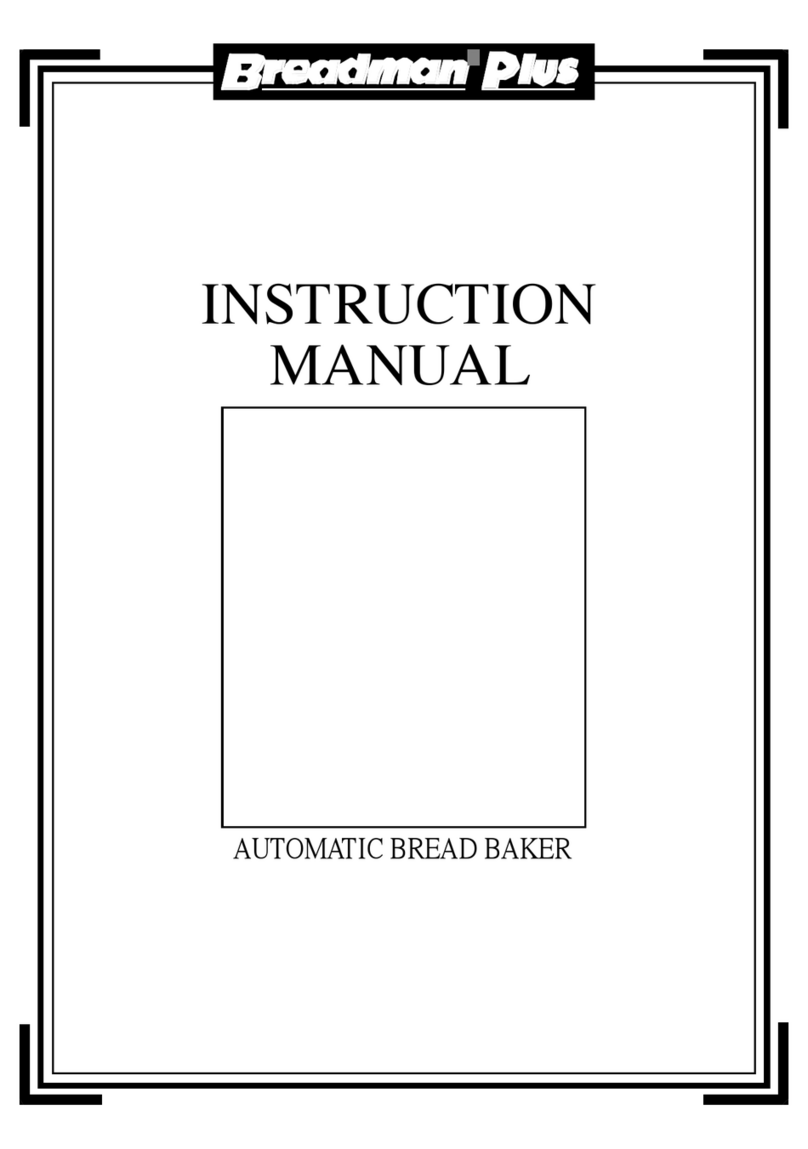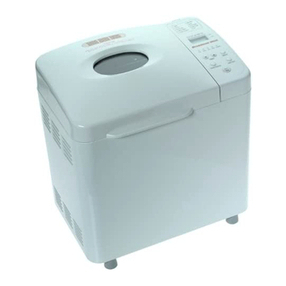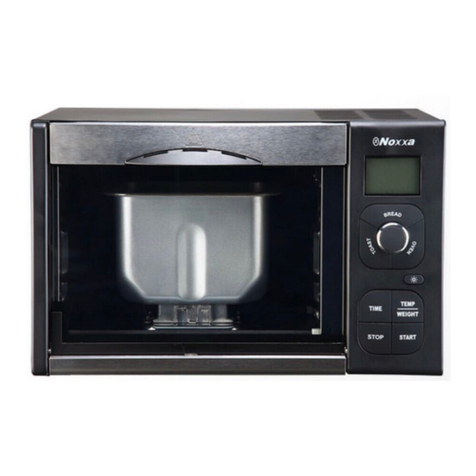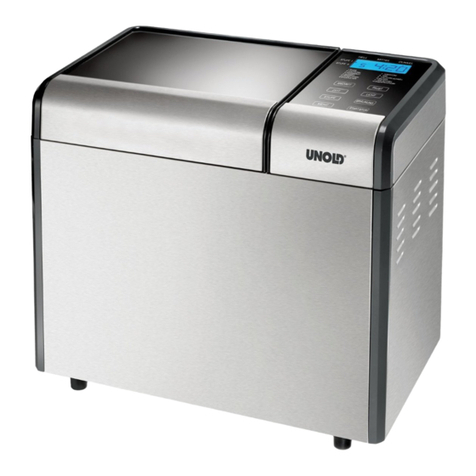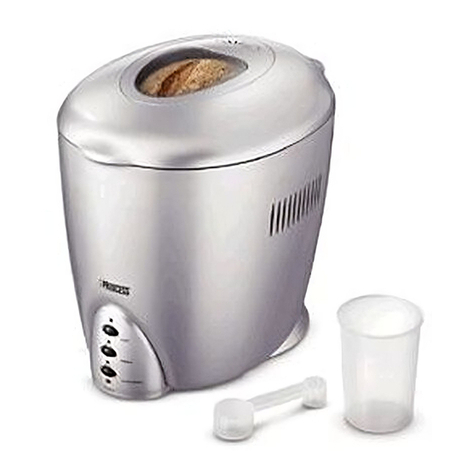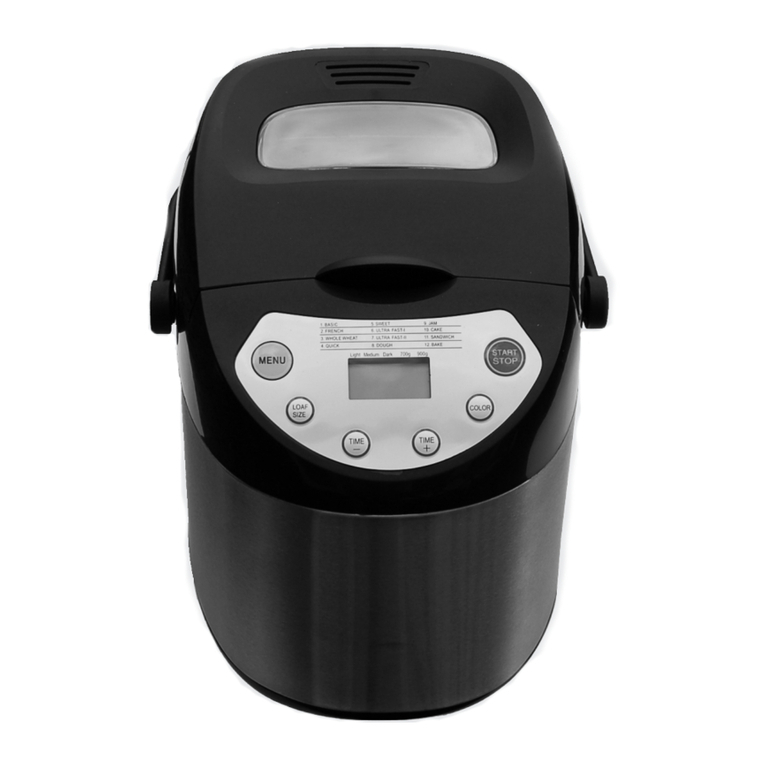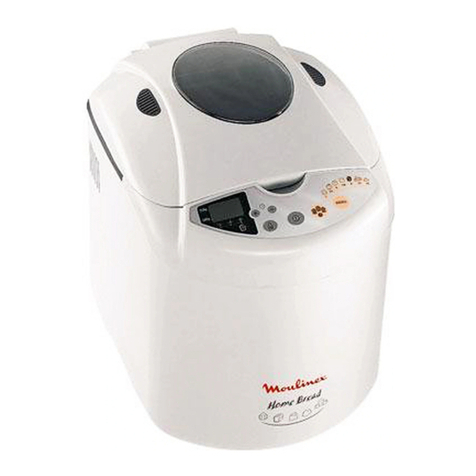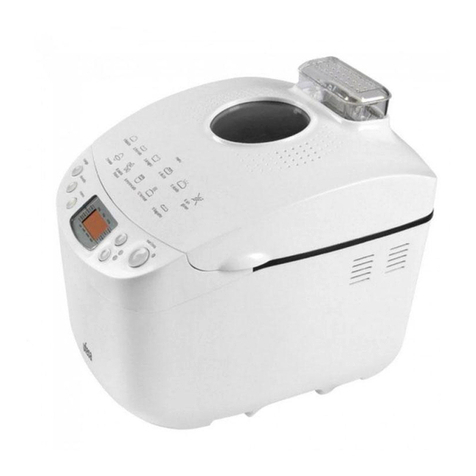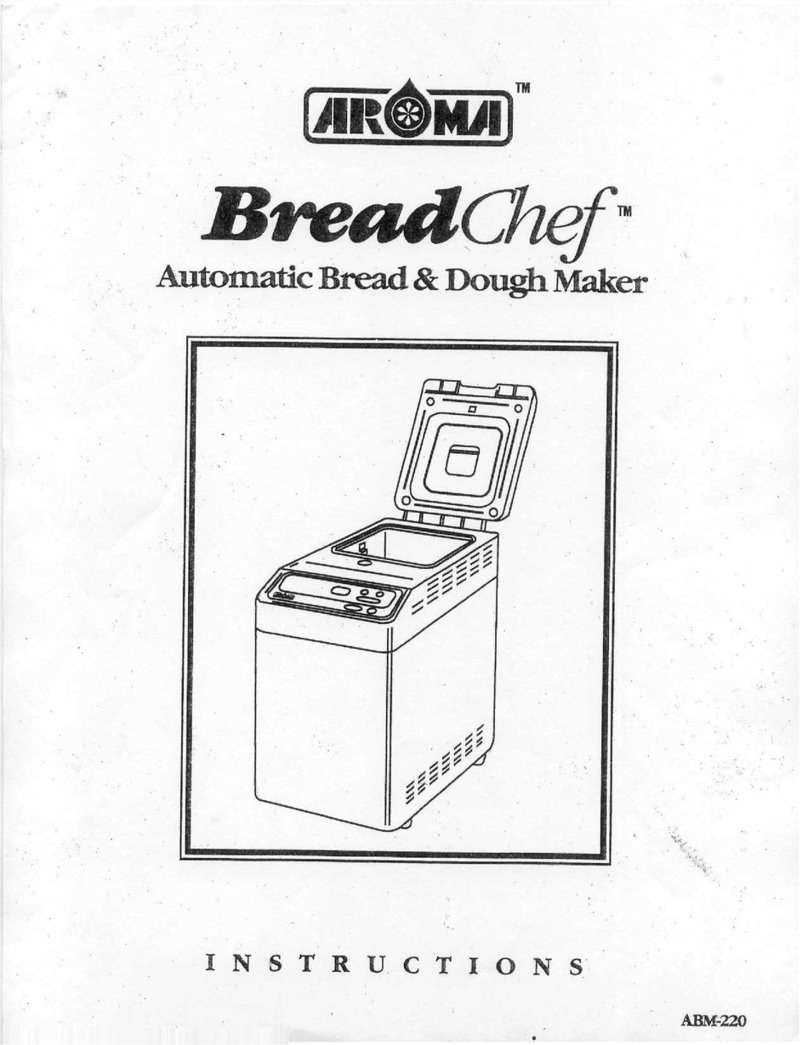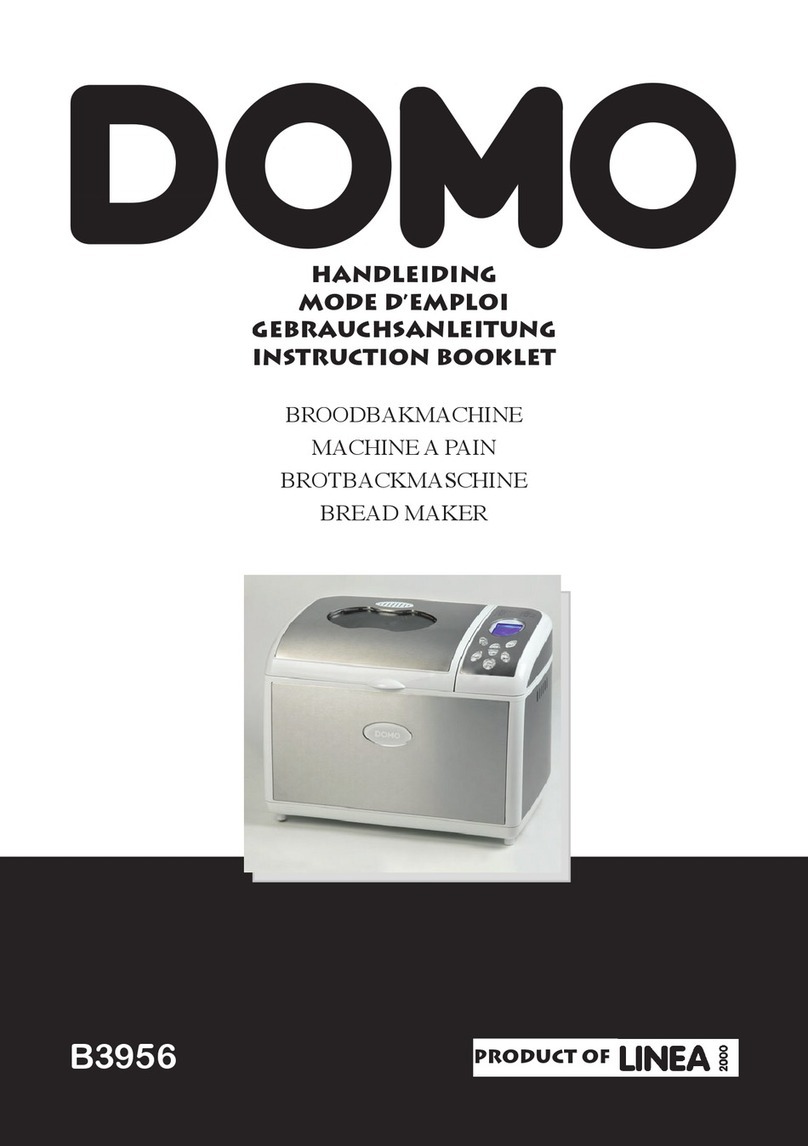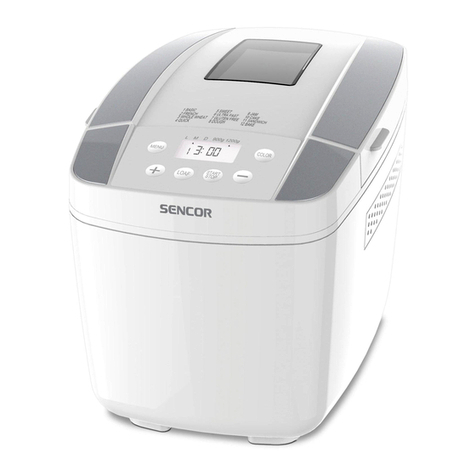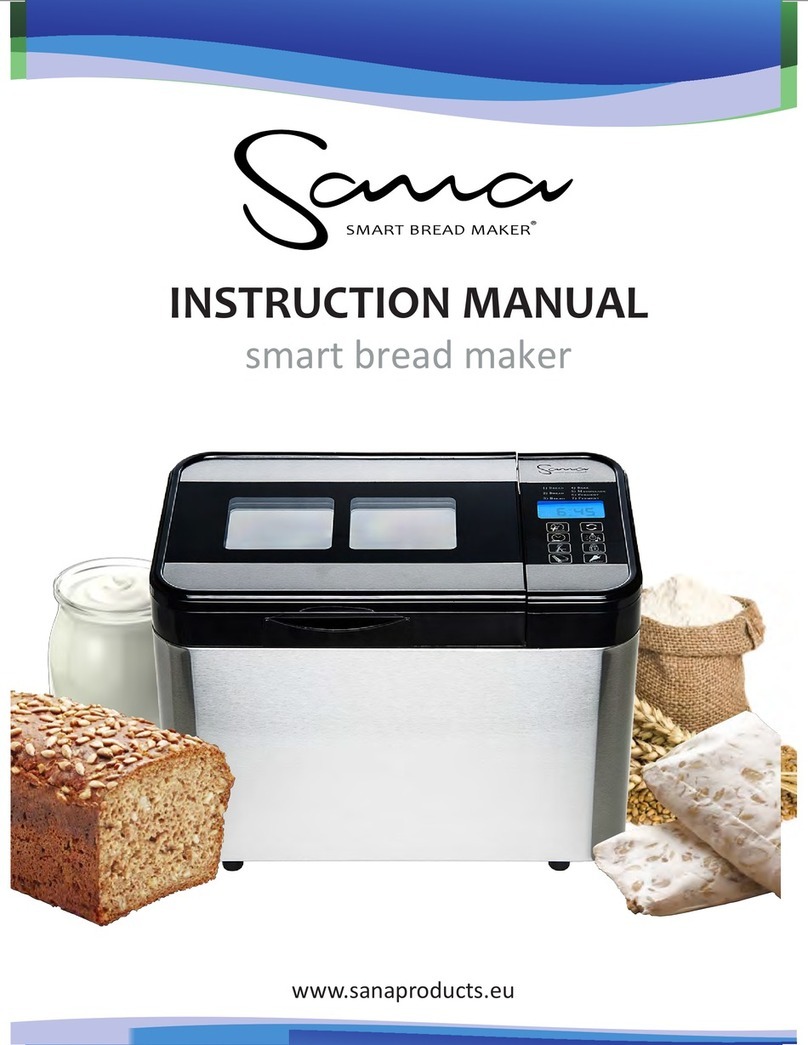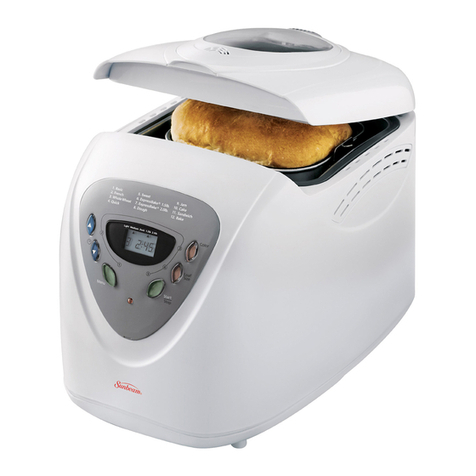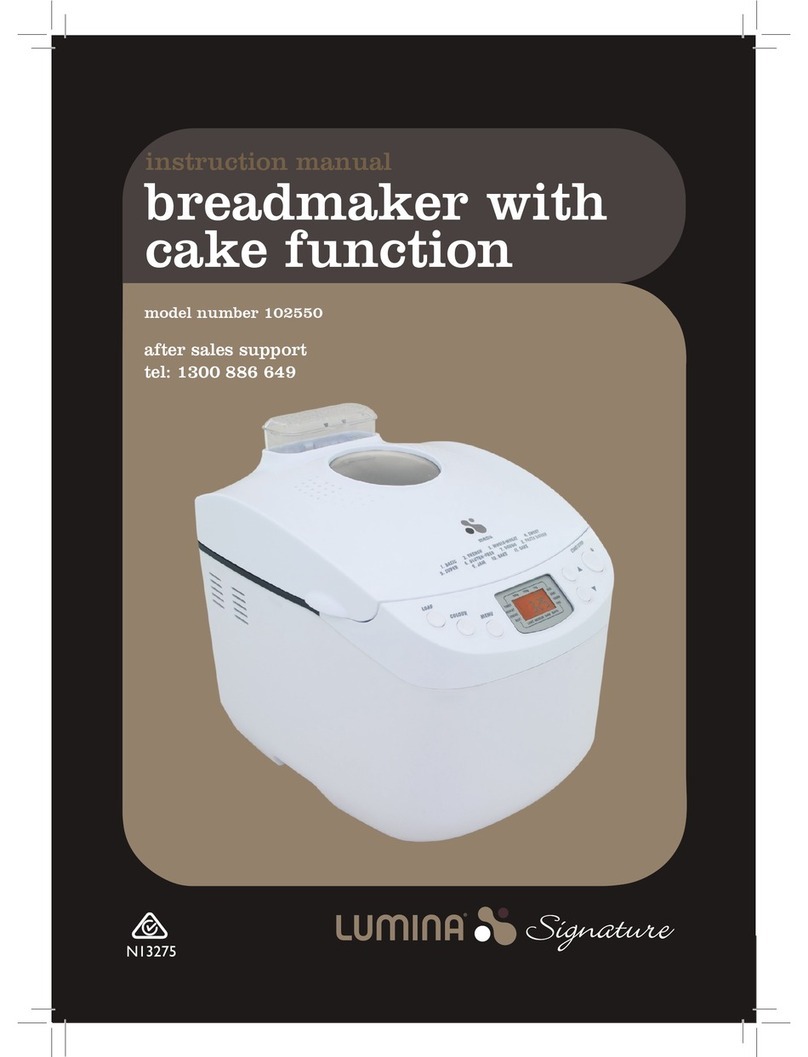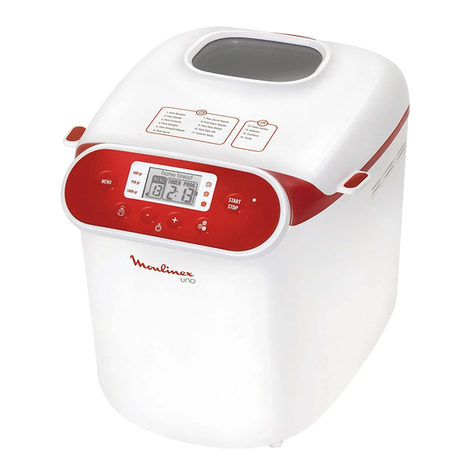15
High-Altitude Baking
In high-altitude areas, over 3,000 feet, dough tends to rise faster as there is less air pressure.
Therefore, less yeast is necessary. For more information on High Altitude Baking guides contact:
Colorado Cooperative Extension Resource Center
Toll free: (877) 692-9358
Website: www.ext.colostate/edu/depts/coopext
In dry climates, flour is drier and requires slightly more liquid.
In humid climates, flour is wetter and will absorb less liquid. Therefore less liquid is required.
Slicing and Storing Bread
For best results, place the bread on a wire rack and allow to cool for
15 to 30 minutes before slicing. Use an electric knife or a serrated knife for
even slices. For rectangular slices, place the loaf on its side and slice across.
Store unused bread tightly covered, (sealable plastic bags or plastic containers work well) at
room temperature for up to 3 days. For longer storage, (up to
1 month) place bread in a tightly covered container in the freezer. Since homemade bread has
no preservatives, it tends to dry out and become stale faster than commercially-made bread.
Leftover or slightly hardened bread may be cut into 1/2-inch or 1-inch cubes and used in recipes
to make croutons, bread pudding or stuffing.
14
Creating Your Own Yeast Breads
Even the most inexperienced baker can achieve the satisfying experience of baking a loaf of
bread. All of the mystery and hard work is gone. Inside this talented Breadman® Bread Maker
is a computer brain which instructs the Bread Maker to mix the dough, knead the dough,
allow it to proof (rise) and bake without you being present. The Breadman® Bread Maker will
also prepare dough for you to shape and bake in a conventional oven. The recipes included
in this book were developed for this Bread Maker. Each recipe features ingredients that best
compliment a particular loaf of bread and each was tested in our Breadman®. It is extremely
important not to exceed the amount of flour specified in each recipe, up to approximately 4 to
4-2/3 cups for BREAD baking cycles and 4-2/3 cups for DOUGH cycles, or an unsatisfactory
baking performance could result. When using your own yeast bread recipes to bake an old
favorite, use recipes in this cookbook as a guide for converting portions from your recipe to
your Breadman® Bread Maker.
Special Glazes for Yeast Breads
Give your just-baked bread a professional finish. After glazing, generously sprinkle with your
choice of poppy, sesame or caraway seeds, if desired. Select 1 of the following special glazes to
enhance your bread.
• Egg Glaze: Beat 1 large egg and 1 tablespoon of water together, brush generously
over dough.
NOTE:Apply to breads just before baking.
• Melted Butter Crust: Brush melted butter over just-baked bread for a softer,
more tender crust.
• Milk Glaze: For a softer, shiny crust, brush just-baked bread with milk or cream.
•
Sweet Icing Glaze: Mix 1 cup sifted icing sugar with 1 to 2 tablespoons of milk until
smooth to make a consistent glaze. Drizzle the glaze over raisin bread or sweet breads
when they are almost cool.
Bread Mixes and Other Recipe Books
You can use prepackaged bread mixes or other Bread Maker recipes in your Breadman® Bread
Maker. Follow package or recipe directions for making 1.5 or 2 LB loaves. Do not exceed the
Bread Pan capacity.
Checking Dough Consistency
Although the Breadman® Bread Maker will mix, knead, and bake bread automatically, when
baking bread from scratch, it is necessary that you learn to recognize the condition of your
dough.The ratio of flour to liquid is the most critical factor in any bread recipe, yet incorrect
measurements are most easily remedied. After 5 to 10 minutes in the 2nd Knead process, open
the Breadman® Bread Maker to check the consistency of the dough. The dough should be
in a soft, tacky ball (sticky like scotch tape). If it is too dry, add liquid 1/2 to 1 teaspoon at a
time. If it is too wet, add 1/2 to 1 tablespoon of flour at a time.
13
Baking Soda
Baking soda is another leavening agent, not to be confused or substituted for baking powder.
It also does not require rising time before baking as the chemical reaction works during the
baking process.
MEASURING YOUR INGREDIENTS
The most important step when using your Breadman® Bread Maker for making bread is
measuring your ingredients. It is very important to measure each liquid and dry ingredient
accurately. For best results, add ingredients into the Bread Pan in the order given in each recipe.
Liquid Measurements
Use transparent plastic or glass liquid measuring cups to measure all liquid ingredients. Place the
cup on a horizontal flat surface and view markings at eye level. The level of the liquid must be
aligned to the appropriate mark of measurement. A “guesstimate” is not good enough, as it could
throw off the critical balance of the recipe.
Dry Measurements
Dry ingredients must be measured using standard size dry measuring cups. These cups are
available in various sizes. Gently spoon dry ingredients into the measuring cup and level off with
a knife. Do not scoop or tap measuring cup, as this will pack the ingredients. This extra amount
could affect the balance of the recipe. Do not sift flour in bread making.
When measuring small amounts of dry or liquid ingredients (i.e. yeast, sugar, salt, dry milk,
honey or molasses), a standard measuring spoon must be used. Measurements must be level,
not heaping.
The Breadman® Bread Maker produces delicious baked goods with ease. This marvelous
appliance asks only that you carefully follow the recipe instructions. In most cooking, a pinch
of this and a dash of that is fine, but this is not the case for automatic Bread Makers. Using this
Breadman® Bread Maker requires that you accurately measure each ingredient.
Measurement/Conversion Chart
1-1/2 tsp = 1/2 TBL 8 TBL = 1/2 cup
3 tsp = 1 TBL 12 TBL = 3/4 cup
1/2 TBL = 1-1/2 tsp 16 TBL = 1 cup
2 TBL = 1/8 cup 3/8 cup = 1/4 cup + 2 TBL
4 TBL = 1/4 cup 5/8 cup = 1/2 cup + 2 TBL
5 TBL+ 1 tsp = 1/3 cup 7/8 cup = 3/4 cup + 2 TBL
12
Conversion Chart for Quick Rise Yeast
3/4 tsp active dry yeast = 1/2 tsp quick rise yeast
1 tsp active dry yeast = 3/4 tsp quick rise yeast
1-1/2 tsp active dry yeast = 1 tsp quick rise yeast
2-1/4 tsp active dry yeast = 1-1/2 tsp quick rise yeast
1 TBL active dry yeast = 2 tsp quick rise yeast
Sugar
Sugar is important for the color and flavor of breads. It also serves as food for the yeast
since it supports the fermentation process. Recipes in this book that call for sugar require
granulated sugar. Do not substitute powdered sugar. In addition, artificial sweeteners cannot
be used as a substitute for sugar as the yeast will not react properly with them. Honey may be
substituted for sugar in equal proportions; reduce the liquid by the same amount.
Salt
Salt is necessary to balance the flavor of breads and cakes. Salt limits the growth of yeast.
Do not increase or decrease the amount of salt shown in the recipes. Dietetically sodium-free
(less than 5 mg sodium per serving) or low salt (less than 1/2 the sodium of table salt) may be
used in equal amounts. The bread will be more coarse.
Liquids
All liquids (except water that is listed with specific temperatures for each cycle in each recipe)
should be warm (80ºF/27ºC) for most recipes. Liquids, such as milk (1%, 2%, whole and skim),
water or a combination of powdered milk and water, can be used when making bread. Milk will
improve flavor, provide a velvety texture and soften the crust, while water alone will produce a
crispier crust. Vegetable or fruit juices and potato water may be used for flavor variety.
Eggs
Eggs add richness and a velvety texture to bread dough and cakes. When the recipe calls for
egg(s) at room temperature, large egg(s) should be used. Liquid egg substitutes may be used as
directed on the carton or 2 egg whites may be substituted for 1 whole egg. They must also be
room temperature.
Fats
Shortening, butter and oil shorten, or tenderize, the texture of yeast breads. French bread gets its
unique crust and texture from the lack of fat added. However, breads that call for fat stay fresh
longer. If butter is used directly from the refrigerator, it should be cut into small pieces for easier
blending during the kneading process.
Baking Powder
Double acting baking powder is a leavening agent used in the PASTA cycle recipes. This type of
leavening agent does not require rising time before baking, as the chemical reaction works when
liquid ingredients are added and again during the baking process.
11
Vital Wheat Gluten
Gluten is manufactured from wheat flour that has been treated to remove nearly all of
the starch, which leaves a very high protein content. (Gluten is the protein in the wheat
that makes the dough elastic.) Gluten is available at most health food stores and in the
baking aisle in many markets. It is sometimes used in small portions with dense, low-
gluten flours (such as whole wheat) to increase volume and lighten texture.
Whole Wheat Flour
Whole wheat flour is milled from the entire wheat kernel, which contains the bran and
germ. This high fiber flour is richer in nutrients than all-purpose or bread flour. Breads
made with this flour are usually smaller and heavier than white loaves. Many recipes mix
whole wheat flour with bread flour or vital wheat gluten to produce a high, light-textured
bread.
Flour Storage
Keep flour in a secure, airtight container. Keep rye and whole wheat flours stored in a
refrigerator, freezer or a cool area to prevent them from becoming rancid. Allow flour to
come to room temperature before using.
NOTE: Flours, while visibly similar, can be very different by virtue of how they were
ground, milled, stored, etc. You may have to experiment with different brands of
flour to help you make the perfect loaf.
Yeast
Active yeast, through a fermentation process, produces carbon dioxide gas necessary
to make bread rise. Yeast feeds on carbohydrates in sugar and flour to produce this gas.
Three different types of yeast are available: fresh (cake), active dry and quick-acting.
Quick or rapid rise or bread machine yeasts are quick-acting. Fresh (cake) yeast is
NOT RECOMMENDED for use with your Breadman® Bread Maker.
Ensure your yeast is fresh by checking its expiration date. Once a package or jar of yeast
is opened, it is important that the remaining contents be immediately resealed and
refrigerated or frozen for future use. Often dough that fails to rise is due to stale yeast.
The following test can be used to determine if your yeast is stale and inactive.
1. Place 1/ 2 cup of hot (110ºF-115ºF/43ºC-46ºC) water into a liquid
measuring cup.
2. Stir 1 teaspoon of sugar into the water and then sprinkle 2 teaspoons of yeast
over the surface.
3. Allow mixture to sit for 10 minutes undisturbed.
4. The mixture should foam and rise to the 1 cup mark. If this does not occur,
discard this yeast and purchase fresh yeast.
NOTE: The basic bread and dough recipes in this booklet were developed using active
dry yeast. You may use the chart below to substitute any quick-acting yeast (quick
rise, fast rise or Bread Maker yeast) for the active dry yeast or vice versa.
10
KNOW YOUR INGREDIENTS
It has been said that cooking is an art that relies on the creativity of the chef. Baking bread
is much more of a science, since the process of combining flour, water and yeast results in
a chemical reaction that produces bread. You must remember that when the ingredients
combine with each other, they produce a specific result. Read the following information
carefully to gain a better understanding of the importance each ingredient plays in the
bread making process.
All-Purpose Flour
All-purpose flour is a blend of refined hard and soft wheat flours ideally suited for making
sweet breads and cakes. The most popular brands of flour have been tested for quick bread
and cakes using the BAKE cycle in the Breadman® Bread Maker with excellent results.
Bran
Bran (unprocessed) is the coarse outer portion of the wheat or rye grains that is separated
from flour by sifting or bolting. It is often added to bread in small quantities for nutritional
enrichment, heartiness and flavor. It is also used to enhance bread texture.
Bread Flour
Bread flour is a high gluten/protein flour that typically has a higher gluten concentration
than all-purpose flour. Using bread flour with the Breadman® Bread Maker will produce
loaves with better volume and structure.
Cornmeal and Oatmeal
Cornmeal and oatmeal come from coarsely ground white or yellow corn and from rolled or
steel-cut oats. They are used primarily to enhance the flavor and texture of the bread.
Cracked Wheat
Cracked wheat has a very coarse texture. It comes from wheat kernels cut into angular
fragments. It gives whole grain breads a nutty flavor and crunchy texture.
Rye Flour
Rye flour must always be mixed with a high proportion of bread flour, as it does not contain
enough gluten to develop the structure for a high, even-grained loaf.
Self-Rising Flour
Self-rising flour contains leavening ingredients that will interfere with bread and cake
making. Self-Rising Flour is NOT RECOMMENDED for use with your Breadman®
Bread Maker.
7 Grain Cereal Blend
7 grain cereal blend is a blend of cracked wheat, oats, bran, rye, cornmeal, flax seeds and
hulled millet.

